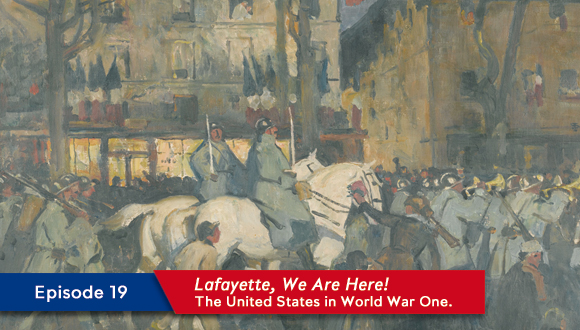
Parade of a regiment at Montrouge on the evening of the Armistice, by Lucien Simon. © Paris, musée de l’Armée, dist. RMN-GP Émilie Cambier
The Great War is Over !
The Armistice of 11 Novembre 1918
Marshal Foch received the German delegation on 8 November 1918 and handed over the Allied Armistice Terms. The German answer was expected on 11 November 1918, before 11 a.m.. The Armistice was agreed on 11 November 1918, and signed at 5 a.m. aboard a carriage of Marshal’s Foch private train parked in a railway siding at the crossroads of Rethondes in the middle of the forest of Compiègne. As the Armistice came in full effect at 11 a.m., bugles resounded all over the Front.
The Paris Peace Conference
From 18 January to 28 June 1919, the Paris Peace Conference brought together delegates from 27 victorious states while the representations of the defeated countries were excluded. The so-called “Council of Four” played a leading role in this conference: Thomas Woodrow Wilson, President of the United States, Georges Clemenceau, President of the French Council, Vittorio Orlando, President of the Italian Council, and David Lloyd George, British Prime Minister. President Wilson’s personal investment in the Conference was particularly important
The conference led to the disappearance of three empires: the German Empire, the Austro-Hungarian Empire and the Ottoman Empire and the emergence of new states such as the Republics of Poland and Czechoslovakia and the Kingdom of Serbs, Croats and Slovenes. The former German colonies were divided up between Great-Britain, France, Belgium, South Africa, the United States and Japan and territories in the Middle East formally under Ottoman rule were mandated to Great-Britain and France by the League of Nations.
The Treaty of Versailles
The Treaty of Versailles was signed between Germany and the Allies on 28 June 1919, five years day to day of the assassination of Archduke Franz Ferdinand at Sarajevo. The Treaty assigned Germany’s liability for reparations. Part I of the treaty created President Wilson’s long-desired Covenant of the League of Nations. The Reparation Commission stated in the Versailles Treaty gathered for the first time on 3 February 1919. On 19 March 1919, the Senate, opposed to the section regarding the League of Nations, rejected the Treaty of Versailles and passed the Knox-Porter Resolution. The United States never joining the League of Nations proved to be a confirmation of American isolationism and a personal failure for President Wilson.
The last gun salute signifying the end of the war wich took place on the esplanade of the Invalides is evoked in a 1919 painting kept in the museum of Blérancourt by French painter Joseph-Félix Bouchor.




Ajouter un commentaire